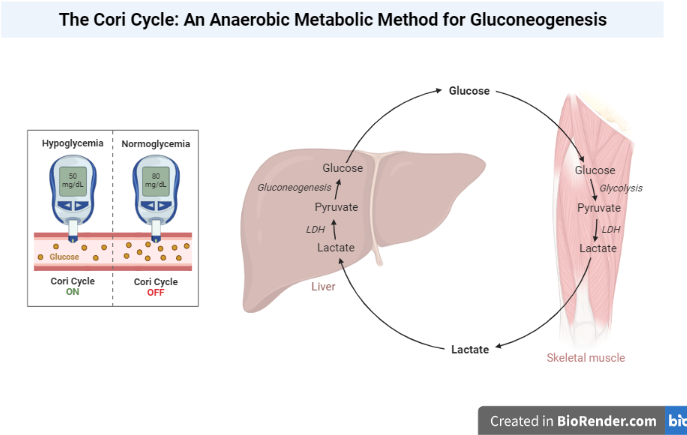Introduction:
It is also known as the glucose-lactate cycle or the lactic acid cycle.
The metabolic pathway in which lactate produced in the muscles is transported through the blood to the liver and converted to glucose, which then returns to the muscles and is metabolized back into lactate is known as the Cori cycle (also known as the lactic acid cycle), and it is named after its discoverers, Carl Ferdinand Cori and Gerty Cori.
It is an anaerobic process in which glucose is converted to lactate in the muscle through glycolysis, and then back to glucose in the liver through gluconeogenesis.
A key precursor for gluconeogenesis is lactate, which is created by working skeletal muscle.
Due to a lack of essential gluconeogenesis enzymes (glucose 6-phosphatase and fructose 1,6-bisphosphatase), lactate or pyruvate generated in muscle cannot be used to synthesize glucose.
It outlines the carbon recycling that occurs across organs when lactate is converted into gluconeogenesis in the liver. Apart from skeletal muscle cells, several additional cell types also produce lactate. such as:
- Red blood cells
- Immune cells in the lymph nodules
- Proliferating immune and blood cells in the bone marrow
- Epithelial cells in the skin.
History:
In 1929, Carl Cori and his wife Gerty Cori discovered the Cori cycle, which they named after themselves. They are both pioneers in the field of understanding how our bodies process carbohydrates.
The 1947 Nobel Prize in Physiology or Medicine was shared by Carl Cori and Gerty Cori.
However, they were awarded for their discovery of how glycogen (animal starch) – a derivative of glucose – is broken down and resynthesized in the body, for use as a store and source of energy.
Steps:
- The conversion of glucose to lactic acid, or lactate, by anaerobic glycolysis in skeletal muscle cells.
- The plasma membrane is freely permeable to lactate. Blood transports lactate out of the skeletal muscle and transports it to the liver, where it is converted to pyruvate.
- The diffusion of lactate from muscle cells into the bloodstream, by which it is transported to the liver.
- The conversion of lactate to glucose by hepatic gluconeogenesis.
- The diffusion of glucose from the hepatocytes into the bloodstream, by which it is transported back to the skeletal muscle cells, thereby closing the cycle.

Fig: Steps in Cori cycle
Significances:
- Under anaerobic conditions, the Cori cycle prevents lactic acidosis (excessive lactate accumulation in muscle).
- This cycle is crucial for producing the energy molecule (ATP) needed for muscle activation since low glucose levels deplete the muscles’ supply of energy. As a result, the Cori cycle provides sufficient energy in the form of glucose, enabling muscles to perform as expected.
References:
- David, L., Nelson, D.L., Cox, M.M., Stiedemann, L., McGlynn Jr, M.E. and Fay, M.R., 2000. Lehninger principles of biochemistry.
- Satyanarayana, U., 2021. Biochemistry, 6e-E-book. Elsevier Health Sciences.
- Voet, D., Voet, J.G. and Pratt, C.W., 2016. Fundamentals of biochemistry: life at the molecular level. John Wiley & Sons.
- Newsholme E.A., Leech T.R. Functional biochemistry in health and disease. John Wiley J. & Sons, Inc., Publication, 2010.
